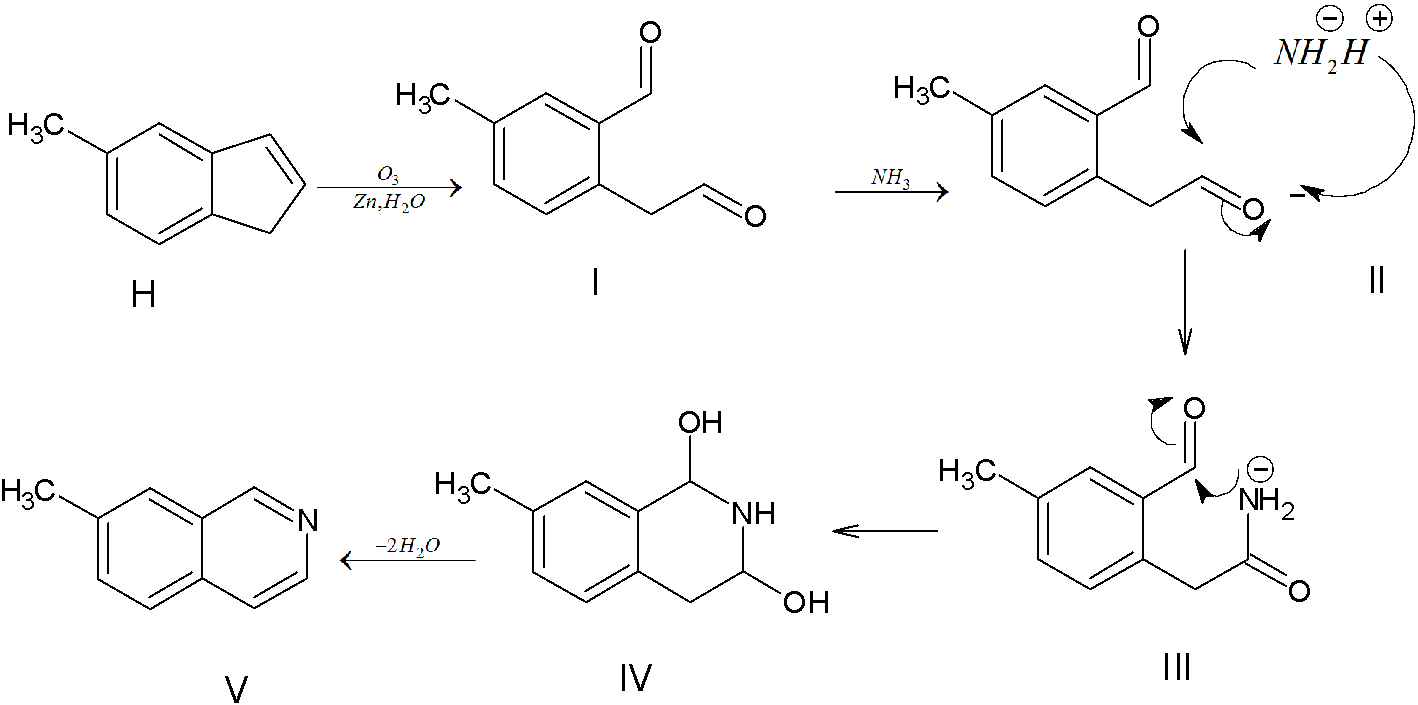
In the following reaction, the product S is:

(A)

(B)

(C)

(D)






Answer
567k+ views
Hint: To solve this question we should know about ozonolysis, reductive workup. A carbonyl group undergoes nucleophilic addition reaction that is whenever nucleophile attacks on carbonyl carbon.
Complete answer:
Let's go step by step reaction for better understanding of the reaction:
Let the
 be' H'.
be' H'.
(I) Ozone molecule is added to molecule H that is molecule H undergoes ozonolysis forming corresponding ozonide. The ozonide formed undergoes reductive workup. In the reductive workup process the ozonide is treated with mild reagents like Zn dust in water or dimethyl sulfide resulting in formation of carbonyl compounds. 5-methyl-2-(2oxoethyl)benzaldehyde is formed after the ozonolysis followed by reductive workup.
(II) Addition of ammonia to 5-methyl-2-(2oxoethyl)benzaldehyde. The ammonia molecule can be represented as $NH_2^ - {H^ + }$. The $NH_2^ - $ attack the carbonyl group. When $NH_2^ - $ attacks the positively charged carbonyl carbon to form a new bond. As the new bond is formed, $\pi - bond$ between the carbon and oxygen is broken. The electron pair goes to oxygen, which acquires a negative charge. The ${H^ + }$ (electrophile) attacks negatively charged oxygen to form the addition product (III)
(III) $NH_2^ - $ attacks other carbonyl carbon due to which a new bond is formed, $\pi - bond$ between the carbon and oxygen is broken. The electron pair goes to oxygen, which acquires a negative charge. ${H^ + }$ ion lost by $N{H_2}$, attacks the negatively charged oxygen. Thus (IV) is formed as the addition product.
(V) Two molecules of water are removed as a result 7-methylisoquinoline is formed.

Thus, option A is the correct answer.
Note:
The nucleophile attacks the positively charged carbonyl carbon to form a new bond. As the new bond is formed, $\pi - bond$ between the carbon and oxygen is broken. The electron pair goes to oxygen, which acquires a negative charge. The electrophile attacks negatively charged oxygen to form the additional product. This type of reaction is known as nucleophilic addition reaction.
Complete answer:
Let's go step by step reaction for better understanding of the reaction:
Let the

(I) Ozone molecule is added to molecule H that is molecule H undergoes ozonolysis forming corresponding ozonide. The ozonide formed undergoes reductive workup. In the reductive workup process the ozonide is treated with mild reagents like Zn dust in water or dimethyl sulfide resulting in formation of carbonyl compounds. 5-methyl-2-(2oxoethyl)benzaldehyde is formed after the ozonolysis followed by reductive workup.
(II) Addition of ammonia to 5-methyl-2-(2oxoethyl)benzaldehyde. The ammonia molecule can be represented as $NH_2^ - {H^ + }$. The $NH_2^ - $ attack the carbonyl group. When $NH_2^ - $ attacks the positively charged carbonyl carbon to form a new bond. As the new bond is formed, $\pi - bond$ between the carbon and oxygen is broken. The electron pair goes to oxygen, which acquires a negative charge. The ${H^ + }$ (electrophile) attacks negatively charged oxygen to form the addition product (III)
(III) $NH_2^ - $ attacks other carbonyl carbon due to which a new bond is formed, $\pi - bond$ between the carbon and oxygen is broken. The electron pair goes to oxygen, which acquires a negative charge. ${H^ + }$ ion lost by $N{H_2}$, attacks the negatively charged oxygen. Thus (IV) is formed as the addition product.
(V) Two molecules of water are removed as a result 7-methylisoquinoline is formed.

Thus, option A is the correct answer.
Note:
The nucleophile attacks the positively charged carbonyl carbon to form a new bond. As the new bond is formed, $\pi - bond$ between the carbon and oxygen is broken. The electron pair goes to oxygen, which acquires a negative charge. The electrophile attacks negatively charged oxygen to form the additional product. This type of reaction is known as nucleophilic addition reaction.
Recently Updated Pages
A man running at a speed 5 ms is viewed in the side class 12 physics CBSE

State and explain Hardy Weinbergs Principle class 12 biology CBSE

Which of the following statements is wrong a Amnion class 12 biology CBSE

Two Planoconcave lenses 1 and 2 of glass of refractive class 12 physics CBSE

The compound 2 methyl 2 butene on reaction with NaIO4 class 12 chemistry CBSE

Bacterial cell wall is made up of A Cellulose B Hemicellulose class 12 biology CBSE

Trending doubts
What are the major means of transport Explain each class 12 social science CBSE

Which are the Top 10 Largest Countries of the World?

Draw a labelled sketch of the human eye class 12 physics CBSE

Explain sex determination in humans with line diag class 12 biology CBSE

The pH of the pancreatic juice is A 64 B 86 C 120 D class 12 biology CBSE

Give 10 examples of unisexual and bisexual flowers




